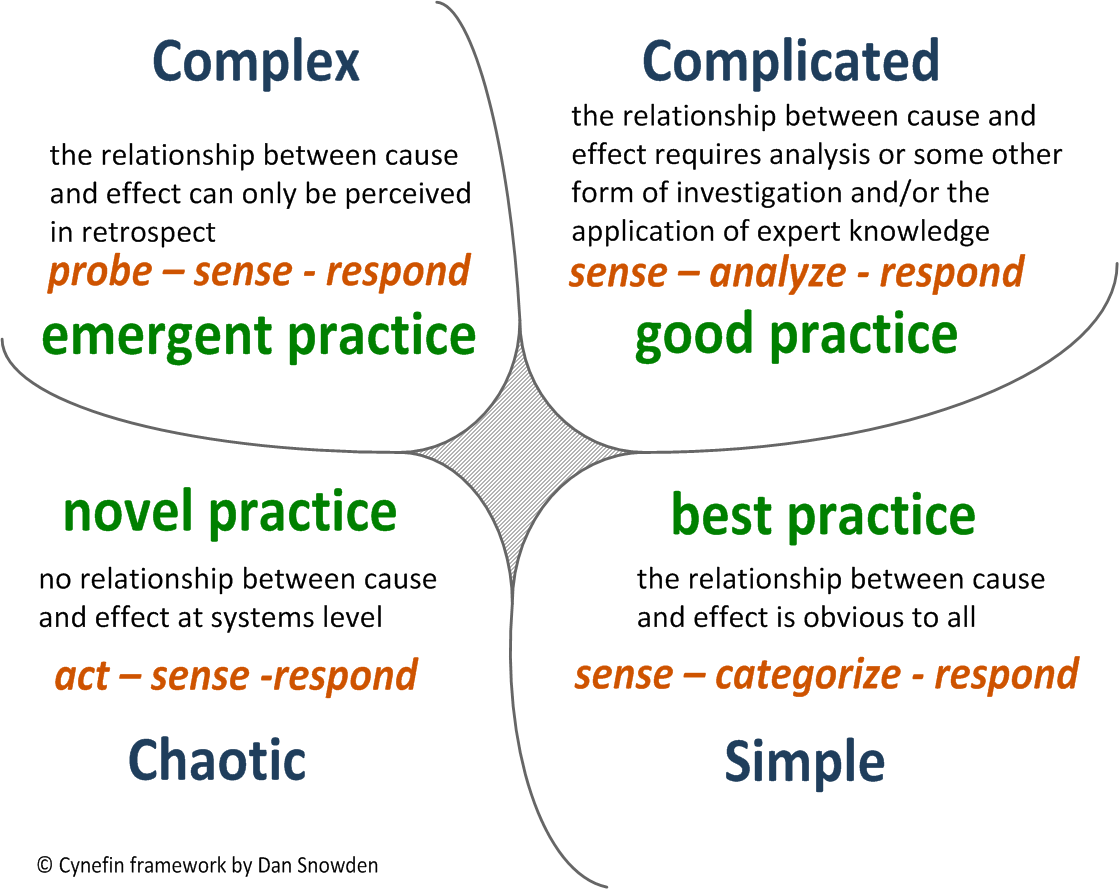A632.8.3.RB - Reflections on the Cynefin Framework
The Cynefin Framework encourages leaders to take different approaches to decision making in different contexts. “Good leadership is not a one-size-fits-all proposition” (Snowden & Boone, 2007, para. 2). The Cynefin Framework categorizes decision into four contexts: simple, complicated, complex, and chaotic. The framework provides decision makers with principles and guidelines to follow when confronted with decisions in each context.
Simple decisions include straightforward thinking and best practices. Leaders are challenged to sense an issue or question, categorize it, and respond appropriately. Complicated decisions are the areas of experts. Best practices are no longer sufficient to overcome this kind of challenge. Leaders sense a problem, analyze how to best overcome it, and respond appropriately (Watkins, n.d.). As challenges become more complex decision makers are forced to recognize that solutions may not yet exist, but will emerge through experimentation. The challenge for decision makers is to probe around the problem, sense the appropriate means of dealing with it, and respond the best they can with the knowledge they have. Dealing with complex problems can be an iterative process. Leaders occasionally have to deal with chaotic situations in which no order is apparent. Decision makers in a chaotic context are challenged to act to establish some order, sense where there is stability, and respond appropriately (Snowden & Boone, 2007).
Although the Cynefin Framework helps decision makers to categorize the context of a decision, many decisions are not so simple to categorize and reside in multiple contexts. Even some decisions that appear to be simple are actually complicated or even complex when all the factors involved are considered. As an example, on one occasion I was flying offshore from an oil platform in the Gulf of Mexico back to the airport. A few minutes into the flight I noticed that my oil temperature gauge was indicating high temperature. According to the rotorcraft flight manual, when the oil temperature is high the pilot is supposed to find a safe place to land as soon as possible. This emergency procedure resides in the simple domain; a recommended best practice exists. However, I was still over 50 miles offshore and there was no safe place to land. My options were to land in the water or continue the flight. I used my knowledge of the aircraft systems and noted that the oil pressure was still Normal, the oil temperature light had not illuminated, and the gauge was acting erratically, jumping from a normal temperature to a high temperature. Based on the information I had I concluded the gauge was faulty and the oil temperature was not high. I elected to continue the flight. Because of my expertise and knowledge of the aircraft I used my judgement to come up with the best solution, even though a best practice existed for the scenario.
It seems that many complicated situations can turn complex quickly. The complicated realm is the domain of subject matter experts. They turn complex when there is no obvious path forward, and one must be discovered. When I was younger I worked for a remodeling contractor who specialized in residential additions. Most of the projects were challenging, but exciting at the same time. We did several projects where we took older single-level homes and added a second story. It was definitely the realm of experts. However, it was very common for complicated scenarios to turn into complex situations. Oftentimes we would come across situations where we had to tie in old plumbing, old electrical, or old structure. Many of these scenarios had no obvious path forward. I recall one specific job that we had to install a forty-foot long beam that weighed over 800 pounds in the living room to hold up the new second floor. We had no idea how we were going to accomplish the task. On a day we had a crane onsite to lift some other beams into place we decided to move the beam for the living room as close to the front door as possible. When the beam was suspended we realized we could get it halfway into the front door since it was suspended by the midpoint. Once we had it half way in we were able to slide the lifting strap and continue moving the beam into the house using the crane. After quite a bit of work using jacks, dollies, and sledge hammers we were able to get the beam installed in the living room using a crane. The path we took to install the beam was discovered one step at a time as we moved forward with the project.
Understanding the Cynefin Framework can improve decision making in numerous ways. Using the framework is instructive in that it demands that leaders consider the context of their decisions. Without the framework leaders may be inclined to use a “one size fits all” technique for decision making. The framework provides a guide and basic principles for decision makers to follow, depending on the context. For example a complex decision should be approached through probing, sensing, and responding. Ideal management occurs in the complicated and complex realms (CognitiveEdge, 2010). Both the chaotic and simple realms tend to stifle innovation and creativity.
Perhaps the key point I have learned from the Cynefin Framework is that decisions occur in multiple contexts. The framework does not serve its purpose if leaders forcefully fit certain situations into individual domains. It works better as a tool to help leaders better understand the domain of their decision and as a guide to determine how to confront the challenges.
References
CognitiveEdge. (2010, July, 11). The Cynefin Framework [Video file]. Retrieved from https://youtu.be/N7oz366X0-8
Snowden, D. F., & Boone, M. E. (2007). A leader's framework for decision making. Harvard Business Review, 85, 68-76. Retrieved from http://search.proquest.com.ezproxy.libproxy.db.erau.edu/docview/227784537?accountid=27203
Watkins, D. (n.d.). What is the cynefin framework? [Powerpoint presentation]. Retrieved from https://erau.instructure.com/courses/90683/files/16973881/download?verifier=LjMpcj3RAtyBVgKRmt1bqbWHm1wlEIPYoEJxQqAa&wrap=1


Comments
Post a Comment